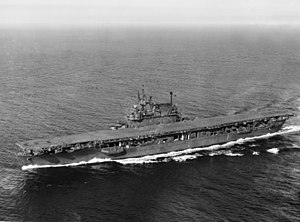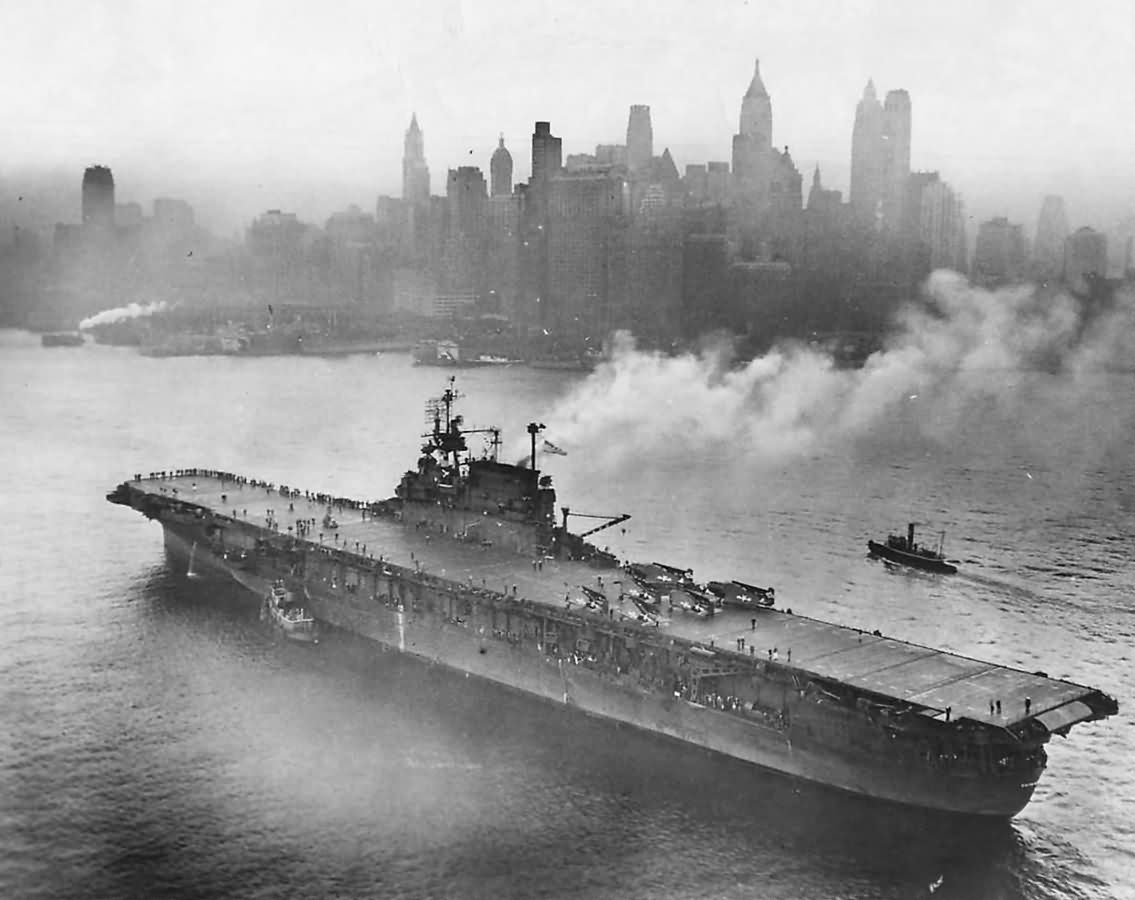CV(N)-6 USS Enterprise Yorkton Class Carrier

Perhaps there's no more famous or decorated ship that bore the name Enterprise then CV-6, the Yorktown Class Aircraft carrier. She displaced over 25,500 tons until her overhaul in 1943 when she came in at a weight of 32,060 tons. She had 9 Boilers and 4 shafts and could move at a speed of 32.5 knots. At the time she was a massive war ship with a crew of 2217 officers of men.
Her flight deck was and hanger were designed to launch, recover and service 90 aircraft. She was bristling with weapons with over 75 guns to protect herself from Air raids.
She was known as the Big E, the Lucky E, The Grey Ghost and the Galloping Ghost. She was commanded through her history by some of the most famous Naval Commanders and Aviators in American history.
She received 20 Battle Stars, a Presidential Unit Citation, a Navy Unit Citation the Philippine Presidential Unit Citation and the Philippine Liberation Medal among other decorations.
She is one of the most famous American Warships in history.

The Enterprise was the 6th American Aircraft Carrier in the US Navy when she was rolled off of the blocks in 1936, and one of only three carriers that were built before WW2 that survived the War.
She rolled out of the Newport News Shipyards on October 3,1936 and was sponsored by Lulie Swanson who was the wife of the Secretary of the Navy, she completed her shakedown and received her pendant on May 12, 1938, her first captain was Newton H White Jr.
One of the first ships to receive early radar she was based out of San Diego, but moved to Pearl Harbor after Roosevelt ordered the Navy to be forward based.
On the 28th of November 1941 she left Pearl to transport aircraft to Wake Island and was out to sea when Pearl Harbor was attacked by the Imperial Japanese Navy. Enterprise returned to Pearl Harbor after the attack and Admiral Halsey ordered the Enterprise to patrol against further attacks, The Enterprise sank the Japanese Sub I-70 becoming the first American ship to sink a Japanese vessel in WW2.
The Enterprises next action was as the flag for Task Force 8, they raided the Marshall Islands sinking 3 ships, damaging 8 and received minor damage before returning to her home port.

The next month the Enterprise swept the Pacific and attacked Japanese installations on Wake and Marcus Islands.
Her next historic moment occurred in April of 1942 when she and her sister ship Hornet launched the Doolittle Raid where 16 B-25's launched from the deck of the Hornet to attack Tokyo while Enterprise provided cover.
At this point, the war was going poorly for the Americans, with the destruction of most of their regular pacific navy at Pearl it force the American's to change tactics and realize that this was was going to be won and lost with carriers not with guns and Battleships. The issue was that the Japanese Navy at this point seemed to be unbeatable with their sizeable force of Carriers and Battleships they held a numbers and technology advantage over the Americans' as well as a experience and leadership edge.
After the Doolittle raid the Enterprise sortied to Coral Sea however she arrived to late to help and the Battle of Coral Sea while considered a saw off as the Americans traded ship losses with the numerically superior Japanese. The Yorkton suffered severe damage and limped back to Pearly leaving the Americans with the Hornet and Enterprise to protect from a suspected Japanese land invasion of the West Coast.

However due to the brilliance of American code breakers and some subterfuge using a false message the American's learned that the Japanese were heading to Midway. At the same time Admiral Halsey came down with Shingles and was beached his choice of his replacement Admiral Raymond A Spruce a former Cruiser Commander was inspired as Spruce performed brilliantly at Midway.
The Hornet, Yorktown who had managed to repair its damage and set to sea in a matter of days instead of months with the Enterprise as the fleet flag steamed out to Midway to bush wack the Japanese Navy.
There was no reason to believe that the Americans' would prevail, the Japanese outnumber the American Carriers 4 to 3 but also had significantly more ships and aircraft. If the Americans' lost their carriers at Midway the war would have probably ended with a Japanese victory .
The Japanese planes unaware of the American Carriers launched their attack on Midway. Shortly after the Japanese started bombing Midway and American Force of Torpedo Planes and Dive Bombers attacked. Torpedo squadron 8 was wiped out but drew Japanese fighter cover to sea level and opened the way for a devastating dive Bomber attack that devastated the Japanese Carriers Kaga and Akagi and left them burning.
As a side note the Battle of Midway exposed the Japanese Carriers as not only having serious design flaws in how they stored ammunition and fuel, but that the Japanese weren't as good at fire fighting and damage control as the American's were. At the same time planes off of the Hiryu caught the Hornet and crippled it with bomb strikes and 2 Torpedo hits, but the Yorkton was able to put out its fires and relight its boilers.
The Enterprise and Hornet struck back and crippled the Hiryu, the American's also crippled the Soryu while planes from the enterprise returned and finished off the Akaga and Kaga.
The Japanese lost 4 carriers a cruiser and 272 aircraft. It had the guts torn out of its experienced pilot roster. The American's lost Yorktown and the Cruiser Hammann and lost a total of 113 aircraft.
Yamamoto ordered the carriers scuttled and retreated. The American's had gutted the Japanese and turned the war.
After Midway, the Enterprise sailed on to join TF-61 and supported the landings in the Solomon Islands. There they caught a strong Japanese taskforce at Guadalcanal and forced the Japanese to abandon their invasion. The Enterprise was lucky to survive after taking 3 bomb hits and she was forced back to Pearl Harbor.
After a month of repairs The Enterprise returned to action at the Battle of Santa Cruz . The Enterprise was struck and seriously damaged but continued on and took on the surviving aircrew from the Hornet which was sank. With the Hornet and Yorktown finished the Enterprise was the only carrier left in the Pacific Fleet and she had suffered heavy damage. The Ship's motto became "Enterprise Vs Japan".
The Enterprise put in for repairs but the Japanese attacked New Caldonia and the Enterprise sortied with a repair crew still on board. During the battle the Seebee detachment continued its repair work as the Enterprise was under attack.
On November 15th 1942 the Enterprise attacked and sand the Hiei the first Japanese Battleship sank during the war. When the Battle of Guadalcanal ended the Enterprise was credited with sinking 16 ships and 8 others, she returned to port for repairs.
After several small scrimmages and with the new American Essex and Independence class carriers coming on line the Enterprise was relieved of duty and returned to Puget Sound for a overhaul.
On November 7th 1943 the Enterprise returned to duty. She participated in the battle of Makin and became the carrier to receive an N at the end of her name and became CVN-6 due to her ability to carrier night fighters.
From there Enterprise headed to the Phillipines and took part in the Battle of the Philippine Sea, the largest carrier battle of the war. The American's savaged the Japanese Navy sinking 3 carriers and destroying 426 Japanese planes in what was called the Great Marianas Turkey shoot. The Japanese had lost most of their most experienced pilots and the American's took advantage of their edge in experience and the American had gained a aircraft quality and technology edge over the Japanese Zero.
From there there the Enterprise assisted in and around the Phillipines before taking place in the Battle of Leyte Gulf. The Enterprise supported attacks on Japanese installations and supported ground operations. On October 23 she fought a 3 day battle with three enemy groups and savaged the Japanese battle ships and destroyers who had little air cover due to the decimation of their carrier forces.
From there she continued to support the American Forces including a night time raid on Tokyo, she then supported the Marines at Iwo Jima including keeping a steady rotation of air cover over a 174 hours.
She then aided in the attack on Okiawa but was struck by a Kamikaze attack suffering her last wound of the war.
With the war over the Enterprise was repaired and participated in Operation Magic Carpet, she bought home POW's and injured Soldiers and military personal due to discharge. In total she returned more then 10,000 American's to their waiting families.

With the end of the war and the American's building 2 dozen larger and more advanced Aircraft Carriers, the Enterprise was deemed surplus. She entered the New York Naval Ship Yard on the 18th of January 1946 to be deactivated. From there she was to become a floating museum but this plan was suspended and money couldn't be raised to save her.
A memorial Plague was installed at Enterprise Tower at the Naval Academy's football stadium, and a permanent exhibit was built at the Naval Aviation Museum in Pensacola. The Ships Bell was given to the Naval Academy where its rung after midshipmen Victories over West Point. The name plate sits near a little league ball park in New Jersey and her commissioning plaque and one of her anchors resides at the Washington Naval Yard.
Tomorrow we'll look at the CVN-64 Enterprise Class Carrier which was the first Nuclear Powered Aircraft Carrier and longest serving ship in the navy.
